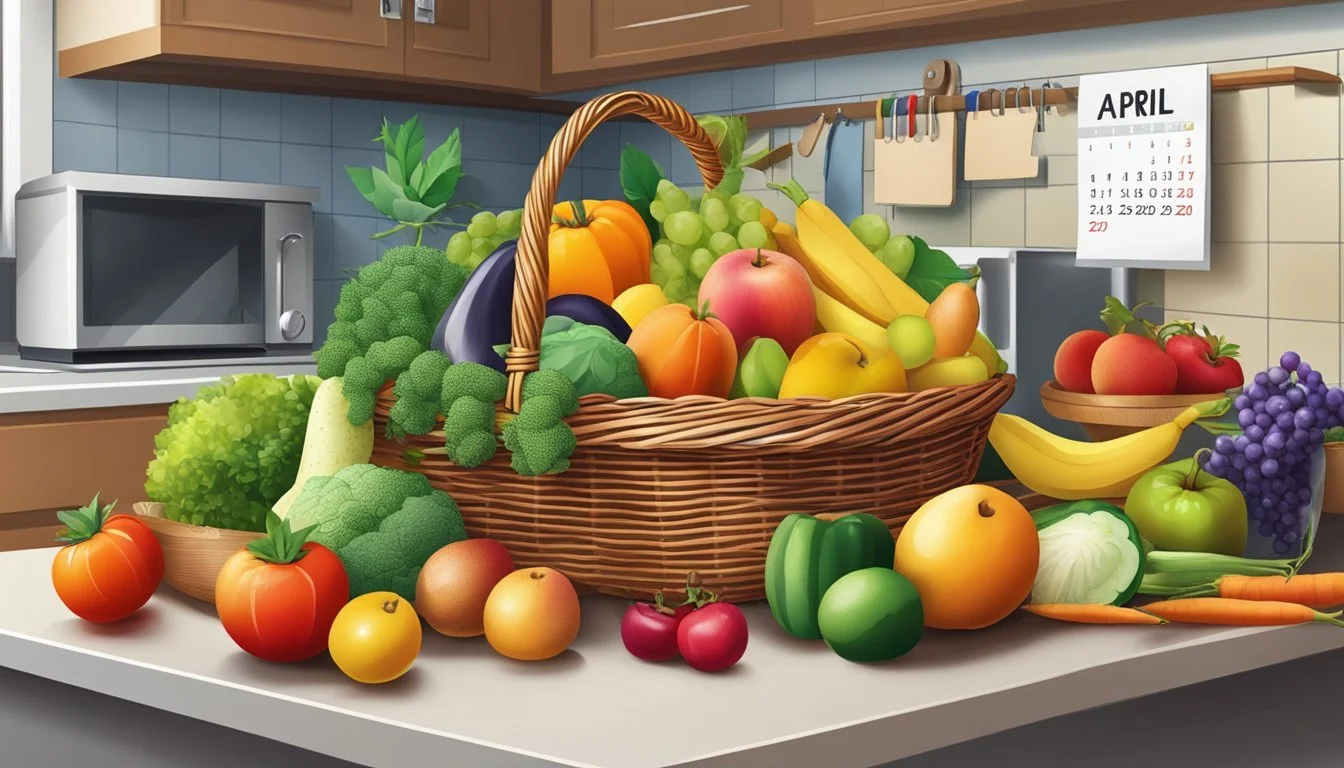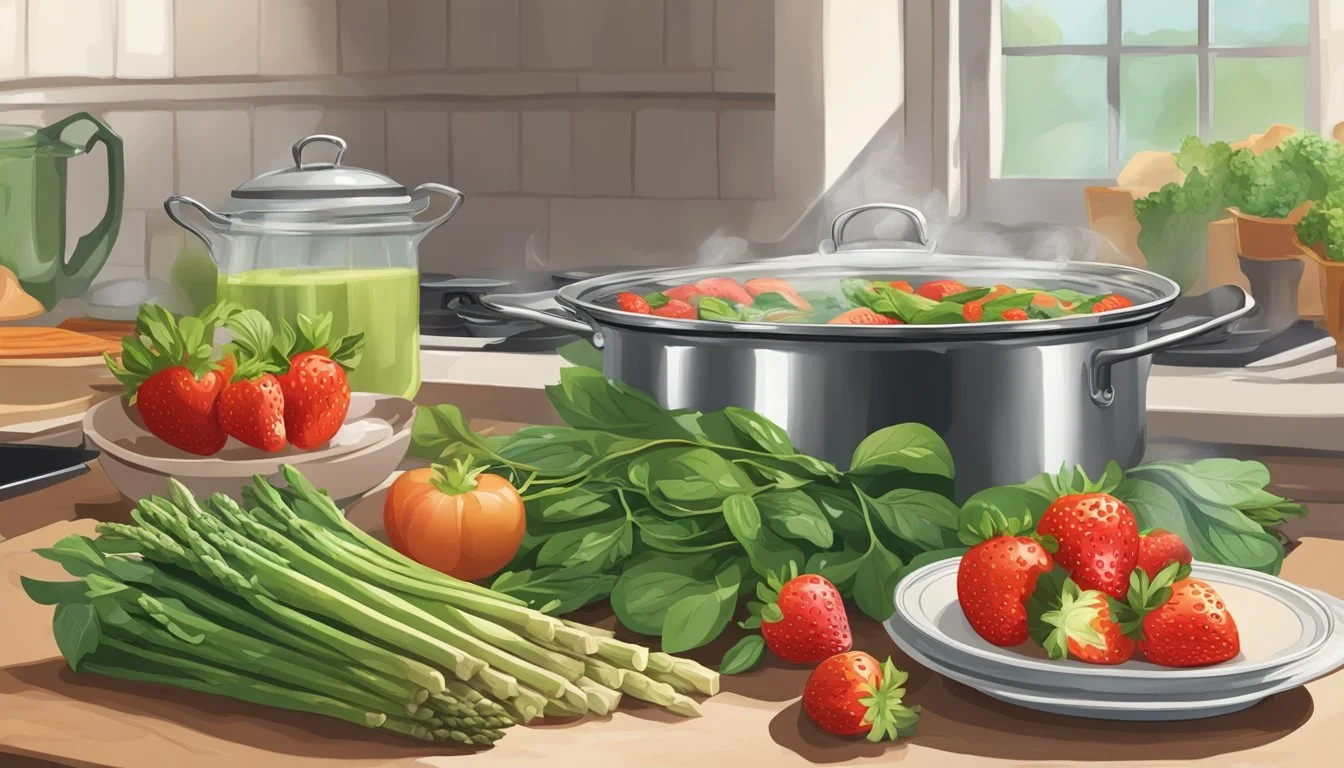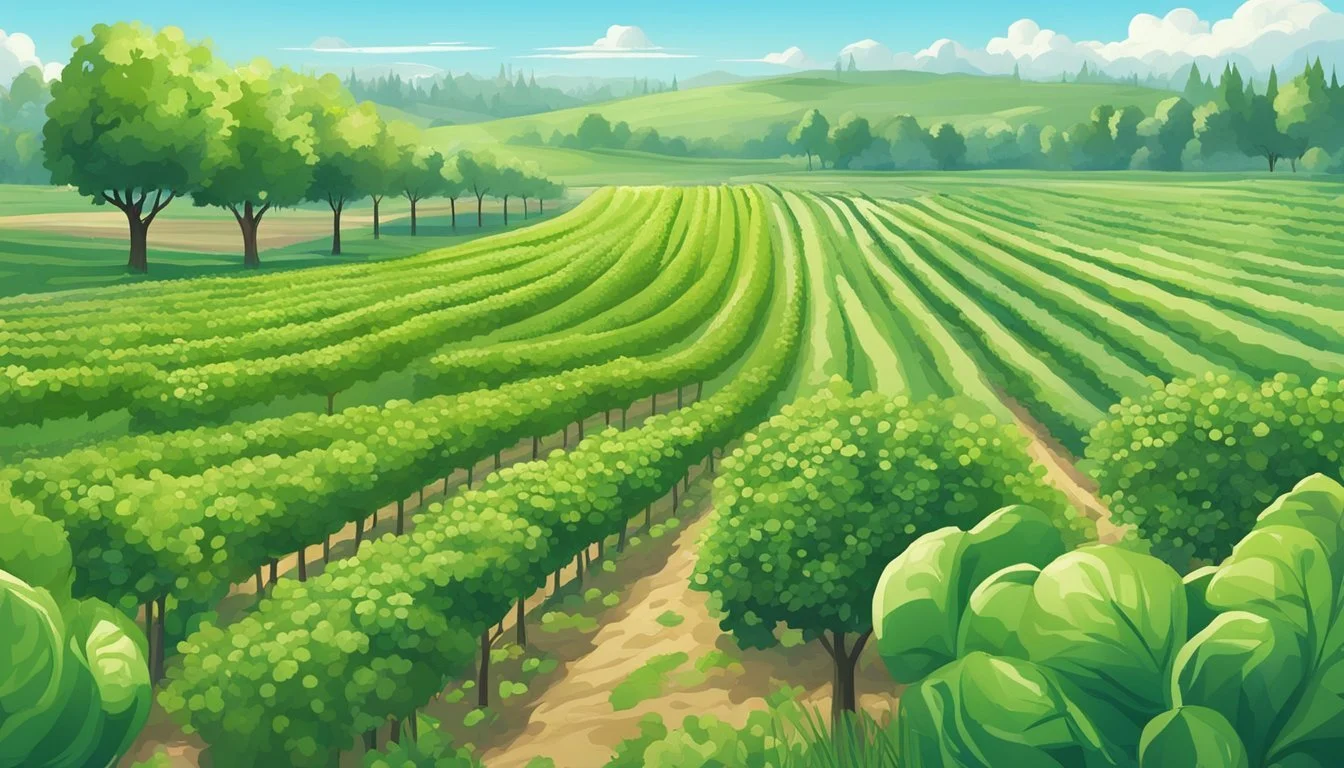Nebraska Seasonal Fruit & Vegetables in April
A Guide to Spring Harvest
This Article is Part of our Nebraska Seasonal Fruit & Veg Calendar
In Nebraska, April marks a period of transition from the cold winter months to the early signs of spring, and with it comes a shift in agricultural production. The state, known for its fertile farmland and diverse agricultural outputs, begins to yield a variety of fresh seasonal produce. Consumers can start to look forward to the fresh flavors that characterize the spring season as the ground thaws and farmers begin planting and harvesting early crops.
While the selection of local fruits is limited in the early spring, vegetables take center stage in Nebraska's April harvest. Early greens, such as spinach and lettuce, often lead the charge, offering crisp textures and refreshing tastes after the heavier fare of winter. Asparagus (What wine goes well with asparagus?) also begins to make its appearance, heralding the coming of a wider variety of produce as the season progresses. This period is an important time for Nebraskans to support local farmers by seeking out the fresh produce available at farmers markets and grocery stores that source locally.
By focusing on seasonally available produce, consumers not only enjoy fresher, more flavorful foods but also contribute to sustainable food systems. The state’s agricultural calendar reflects the rhythm of the seasons, and April in Nebraska showcases the beginning of this fruitful time of year. Embracing these early spring offerings lays the groundwork for the bounty of fruits and vegetables that will ripen in the warmer months to come.
Overview of Nebraska's Growing Season
Nebraska's diverse climate and fertile soils provide a rich canvass for a variety of seasonal fruits and vegetables. With a focus on sustainable farming and local community support, Nebraska’s agricultural calendar defines the rhythm of planting, growing, and harvesting, contributing significantly to the state's economy and freshness of produce available to consumers.
Understanding Nebraska's Climate
Nebraska experiences a continental climate, with cold winters and warm summers. Spring in Nebraska starts in March with inconsistent temperatures that can impact early planting schedules.
Key Planting and Harvest Times
Most planting in Nebraska begins in spring (March to May), with the harvest season extending from June to October. April marks a pivotal time for planting crops, which will be harvested in the late summer or fall.
Agricultural Economy
Agriculture is a cornerstone of Nebraska's economy, with farms contributing to both local and national markets. The timely planting and harvesting of crops are critical to ensuring the economic stability of the state's farming sector.
Importance of Seasonal Produce
Seasonal produce ensures peak freshness and nutrition. It also supports Nebraska's agricultural economy by reducing transportation costs and providing consumers with fruits and vegetables at the height of their flavor.
April's Significance in Nebraska
April is a busy month for Nebraska farmers as they prepare for the pivotal planting season. Fields come to life as the risk of frost decreases and longer daylight hours are available.
Regional Variations Within Nebraska
Nebraska's large geography results in regional variations in climate and soil, affecting what can be planted and when. For instance, the panhandle may have differing seasonal schedules compared to the eastern part of the state.
Sustainable Farming Practices
Nebraska farmers are increasingly embracing sustainable practices to mitigate climate change and improve soil health. This includes crop rotation, minimal tillage, and integrated pest management.
Challenges Facing Nebraska Farmers
Nebraska farmers face challenges such as extreme weather, disease, and market fluctuations. Ensuring crops are resilient and can withstand unpredictable conditions is an ongoing concern.
Opportunities for Local Community Support
Local support for Nebraska farms is vital. Community engagement through farmers markets, CSA programs, and supporting local recipes helps sustain the farming economy and encourages fresh, local consumption.
Nebraska Seasonal Calendar Overview
Month Seasonal Produce April Planting Begins June Early Harvest October Main Harvest
April’s spring climate lays the groundwork for the planting season, which is essential for a successful harvest in the following months, providing fresh, seasonal produce for both local and state markets.
Seasonal Fruits in April
April in Nebraska brings about a transition from dormant orchards to burgeoning fruit blooms. This month sees the beginning of a fruitful season, with a variety of fruits starting to show signs of the coming abundance.
Strawberries in Early Growth
Strawberries start their growth cycle in April, with farmers closely monitoring the young plants for frost damage. Early varieties may begin to flower, requiring protection from late spring frosts to ensure a successful harvest.
Apple Varieties and Their Maintenance
April is crucial for apple orchards; the trees are pruned and maintained to support the forthcoming growth. Heirloom and modern varieties both demand specific care, with the anticipation of flowering and fruit setting.
Spring Berries Introduction
Blueberries, raspberries, and cherries all enter the earliest stages of seasonal growth in April. Nebraska's climate is ideal for these berries, which need well-draining soil and partial to full sunlight to thrive.
Blueberries: Soil preparation and pH adjustments are key.
Raspberries: Support structures for the canes are typically checked and repaired.
Cherries: Pest management starts as buds begin to appear.
Importance of Melons Planting
Planting for melons, including watermelons and cantaloupes (how long does cantaloupe last?), starts in April to take advantage of Nebraska's warm summers. Strategic planting ensures each vine has enough space to flourish and access to full sun.
Tropical Fruit Adjustments
While Nebraska's climate is not ideal for tropical fruits, April is a month where enthusiasts may begin planting these in controlled environments. Adjustments include greenhouse preparations for fruits like peaches, pears, and plums.
Nebraska's Lesser-Known Fruits
Nebraska also fosters lesser-known fruits that are adapted to its unique climate, commencing their season in April. This includes indigenous fruit varieties that provide a local twist to the seasonal produce palette.
Seasonal Vegetables in April
In Nebraska, April brings a diverse array of vegetables to the table, each transitioning from the dormancy of winter into the burgeoning growth of spring.
Leafy Greens Emergence
Leafy greens such as lettuce, kale, arugula, and spinach are at their tender and flavorful peak. These spring staples can be found in abundance, offering bright leaves perfect for nutritious salads.
Lettuce: Varieties like romaine, butterhead, and leaf
Kale: Curly, Red Russian, and lacinato types
Arugula: Often spicier in the cooler spring temperatures
Spinach: Smooth and crinkly leaf varieties
Root Vegetable Varieties
April's soil nurtures a selection of root vegetables. Fresh carrots, beets, radishes, and turnips feature prominently in seasonal dishes, celebrated for their crisp textures and earthy flavors.
Carrots: From sweet, orange classics to heirloom colors
Beets: Deep reds and golden hues, both round and cylindrical types
Radishes: Red globes to elongated white daikons
Turnips: White-fleshed with a purple-tinged skin
Cruciferous Vegetables and Health
Cruciferous vegetables like broccoli, cauliflower, and cabbage thrive in the cooler early spring climate. Their health benefits are as notable as their versatility in dishes. Brussels sprouts also make a brief appearance, rounding out the cruciferous offerings.
Broccoli: High in fiber and vitamins C and K
Cauliflower: Rich in sulforaphane, known for its potential cancer-fighting properties
Cabbage: Green and red varieties, ideal for slaws and ferments
Allium Family Highlights
The allium family, featuring onions, leeks, and garlic, begins to show signs of readiness. They impart foundational aromatic flavors to a multitude of spring recipes.
Onions: Young "green" onions ready for harvest
Leeks: Characterized by their mild onion-like taste
Garlic: Early green garlic shoots are milder than mature cloves (how long do cloves last?)
Early-Season Legumes
Beans and peas signify the arrival of spring legumes. They are harvested early in their growth for maximum sweetness and tenderness.
Beans: Including fava and snap beans, neither requiring shelling
Peas: Sweet peas and crunchy sugar snap peas
Squash Family Planting
While it may be too early to harvest, April is the time for planting varieties of squash. This includes summer squash like zucchini and yellow squash, as well as winter squash such as butternut, acorn, and spaghetti squash.
Summer squash: Includes zucchini and yellow crookneck squash
Winter squash: Options include butternut, acorn, and spaghetti squash that'll mature later in the season
Choosing and Storing April Produce
In April, individuals have the opportunity to select and store an array of seasonal produce in Nebraska, ensuring maximum freshness and flavor. Knowing proper selection and storage techniques can extend the longevity of fruits and vegetables.
Selecting Prime Produce
When shopping for April produce, one should look for fruits and vegetables with vibrant colors and firm textures, which are indicators of freshness. For example, asparagus should be bright green with tightly closed tips, and radishes should be firm, without blemishes.
Storage Techniques for Longevity
Fruits: Most fruits like strawberries and apples should be stored in the refrigerator to slow down ripening and preserve flavor. However, items like avocados can be kept on the counter until they’re ripe before refrigeration. Vegetables: Fresh vegetables, particularly leafy greens, benefit from refrigeration in a crisper drawer. Many root vegetables, such as turnips, should be stored in a cool, dark place to maintain their texture and taste.
Best Practices for Vegetable Preservation
To preserve vegetables, they often need to be kept in a humid environment within the refrigerator. Wrapping leafy greens in a damp paper towel before placing them in a bag can maintain moisture. Vegetables like asparagus may be stored upright in a glass of water to keep them hydrated.
Understanding Ripeness and Flavor
Ripeness greatly affects flavor, with peak ripeness being the optimal time for consumption. A ripe tomato, for instance, will have a bright, even color and slight give under pressure. Fruit such as peaches should emit a sweet fragrance and feel slightly soft at their stem.
Cooking and Recipes
In April, Nebraska's culinary scene comes alive with an array of seasonal fruits and vegetables. Cooks have the opportunity to create fresh, flavorful dishes that celebrate the arrival of Spring.
Seasonal Recipes for April
Spring in Nebraska ushers in a variety of fresh produce suitable for vibrant and nourishing recipes. Asparagus can be roasted or grilled, while radishes bring a peppery crunch to salads. Spring greens can be used for light soups or as a base for salads, complemented by sweet onions that add a gentle, aromatic flavor.
Roasted Asparagus with Lemon: Simple roasting highlights the fresh, earthy flavor of asparagus, with a splash of lemon for brightness.
Radish and Spring Greens Salad: A refreshing combination that pairs the crunch of radishes with tender greens.
Pairing Flavors With Nebraska Produce
The key to creating exceptional dishes with Nebraska's April harvest lies in understanding flavor pairings. Rhubarb, often paired with strawberries, offers a tart contrast to sweet desserts. Sweet peas bring a subtle sweetness to dishes that blend well with herbs like mint or basil.
Strawberry-Rhubarb Pie: A classic pairing where sour meets sweet.
Pea and Mint Risotto: The mint amplifies the fresh taste of seasonal peas.
Healthy Eating with Spring Harvest
April's harvest provides numerous options for health-conscious meals. Leafy greens like spinach and lettuce are ideal for salads rich in vitamins and minerals. Artichokes are a great source of fiber and can be steamed or incorporated into dips.
Spinach Salad with Vinaigrette: A light, vitamin-packed starter or side.
Steamed Artichoke Hearts: A heart-healthy option that can be enjoyed with a variety of dips.
Traditional Nebraska Dishes
Nebraska's food culture includes recipes that are passed down through generations and often utilize April's produce. Dishes like bierocks (meat-filled pastries) might feature spring onions or cabbage, while sweet corn, when available early, can be incorporated into various casseroles.
Spring Onion Bierocks: A Nebraska classic with a fresh, spring twist.
Sweet Corn Casserole: A heartwarming dish that is a staple in many Nebraska homes.
Preserving Techniques for Fruits and Vegetables
Preserving the abundance of April's fruits and vegetables allows Nebraskans to enjoy their local produce year-round. Methods such as canning, freezing, and pickling are traditional ways to extend the shelf life of foods like beets and berries.
Canned Beets: Pickled or plain, canning beets retains their earthy flavor.
Frozen Berries: Flash freezing berries ensures they're ready for smoothies or recipes throughout the year.
Gardening Tips for Home Growers
In Nebraska's diverse climate, successful gardening in April requires careful planning and execution. From starting your garden to everyday maintenance, adherence to tested methods will help ensure a productive yield.
Starting Your Own Garden
When initiating a garden, selecting quality seeds and proper planting techniques are paramount. Home growers should invest in seeds suited for Nebraska's climate. April is a transitional month, so focus on cool-season crops like kale and lettuce. They should start these seeds indoors or in a protected space to safeguard against late frost.
Preventing Common Plant Diseases
Plant diseases, often caused by fungus or pests, can devastate crops. To prevent these, gardeners should practice crop rotation and avoid overhead watering, which can create damp conditions favorable to disease. They should remove any diseased plants promptly to prevent spread.
Organic Gardening Practices
Organic gardening emphasizes sustainable practices, avoiding synthetic chemicals. Natural compost can enrich soil, while introducing beneficial insects can help control pests. Gardeners should opt for organic-approved fungicides to manage plant diseases.
Optimizing Your Garden Layout
A well-designed garden optimizes space and promotes healthy plant growth. Gardeners should consider companion planting: growing herbs alongside vegetables, for example, can enhance flavor and deter pests. They might place taller plants on the north side to prevent them from shading smaller plants.
Watering and Maintenance
Effective watering is critical to garden health. Plants should be watered deeply but infrequently to encourage strong root development. Drip irrigation systems can ensure consistent moisture with minimal water waste. Regular maintenance is key; weeding and monitoring for pest activity should be done consistently.
Growing Herbs Alongside Produce
Herbs are not only flavorful but can also support the health of a garden through companion planting. Plants like basil and dill attract beneficial insects and can improve the growth and flavor of nearby vegetables. They require less space and can be easily integrated between vegetables or in borders.
Conclusion
April in Nebraska presents a burgeoning period for local produce. One can find an array of fresh vegetables that are adaptable to the state’s early-spring climate. Root vegetables like carrots and beets, along with green onions, are notable staples, and greens such as spinach and lettuce thrive during this time. These vegetables can be a great addition to a healthy diet due to their high vitamins and minerals content.
The choice to support local agriculture by purchasing seasonal produce not only delivers nutritional benefits but also contributes to sustainable practices and the local economy. Consumers should note that while fruit options may be limited in April, as many fruit crops peak later in the year, the anticipation for summer’s bounty begins with the planting of fruit trees and vines in spring.
Shoppers should look forward to the upcoming months when local markets will be brimming with a wider variety of fruits like strawberries, which usually make their entrance in late spring, and anticipate the succession of fruit harvests that Nebraska offers as the seasons progress.
In summary, April’s selection reinforces the importance of eating seasonally and regionally. As growers prepare for a richer harvest, consumers can appreciate and utilize the available produce to foster a deeper connection with the region's farming cycles.
References
To gather information on Nebraska's seasonal fruits and vegetables available in April, several resources have been consulted. These sources provide research and data regarding produce availability and harvest times specific to the region.
Farm Flavor: Offers a produce calendar which includes details on the optimal times to find the freshest produce in Nebraska.
Nebraska Crop Harvest Calendar: Lists specific fruit and vegetable harvest dates, providing residents and visitors with a timeline of fresh produce availability throughout the year.
UNL Food: Through the University of Nebraska-Lincoln Extension, this resource shares insights on enjoying seasonal produce, with emphasis on local gardens and farmers markets.
Seasonal Produce Guide: Supplies a broad guide to the seasonality of fruits and vegetables, assisting in menu planning and highlighting variations due to growing conditions and weather.
These references are instrumental for anyone seeking to understand the seasonal patterns of produce in Nebraska, ensuring information is accurate and up-to-date. They serve as guides for both consumers and growers to enable informed decisions about when and where to source local fruits and vegetables.
The combination of calendars, guides, and academic extensions provides a wide-ranging and reliable set of information for assessing the state's seasonal crops.
About the Author
The author of this article, endowed with a Master's degree in Horticulture from the University of Nebraska, has spent over a decade immersed in the agricultural sector of the Midwest. Their expertise is rooted in sustainable farming practices and seasonal crop cultivation, with a special focus on the diverse climate of Nebraska and its impact on plant growth.
With numerous published articles on regional agriculture, the author is a trusted voice in guiding both novice gardeners and seasoned farmers. They have contributed to various agricultural journals and local newsletters, making complex horticultural knowledge accessible to a broad audience.
The author's work often includes detailed crop calendars and growth strategies that respond to the unique growing seasons of Nebraska. Their research methods combine field observations with data analysis, ensuring that their recommendations are scientifically sound and practically viable.
As a member of several professional horticulture associations, the author stays abreast of the latest advancements in farming techniques and environmental conservation. In addition to their educational background, these affiliations underpin their competency and dedication to informing others about the intricacies of regional agriculture.










